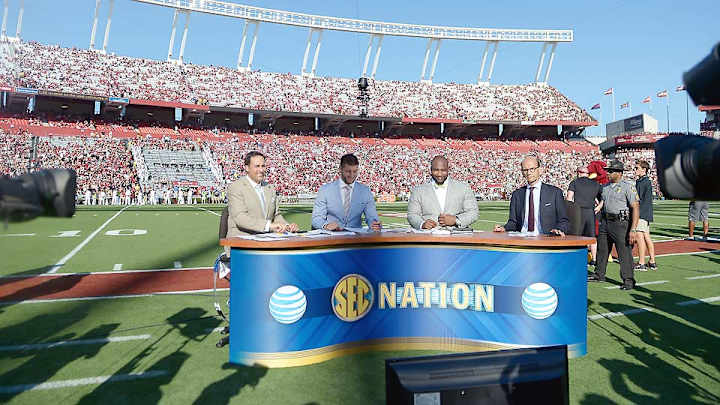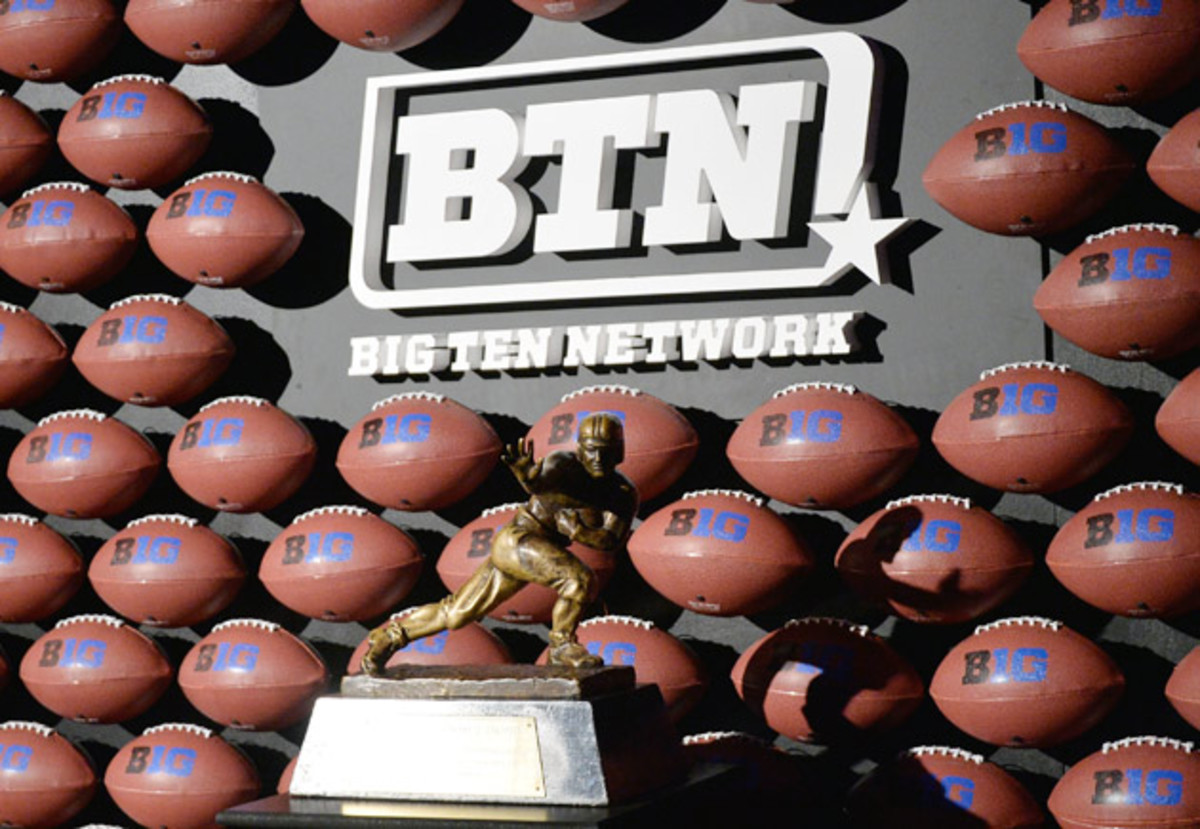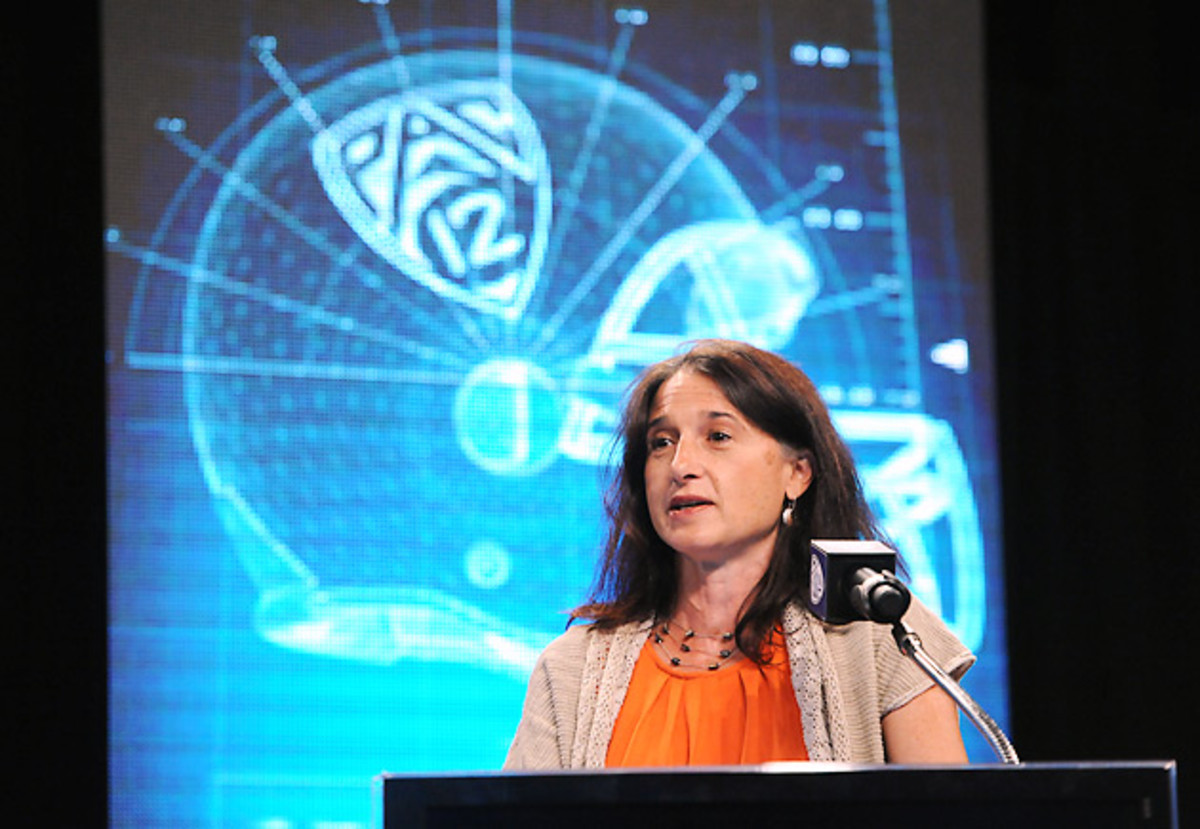Wild success of SEC Network creating Titanic Two of conference finances

DESTIN, Fla. — I can’t remember exactly how I worded the question, but I remember Mike Slive’s reaction. It was May 2011, and the SEC commissioner was rolling his work materials through the Hilton Sandestin while moving from one meeting to another. I asked if the SEC, which had made a 13-year, $3 billion deal with ESPN and CBS two years earlier, could do anything to close the gap on the Pac-12’s then-new media rights deal, which sold far fewer football games for the same amount of money in one fewer year. “Why would you ask that?” Slive retorted. The only answer he offered was obvious aggravation.
Friday, the outgoing commissioner offered a definitive answer to that question. Yes, the SEC was working on a solution. And it turned out to be a monster.
Thanks in major part to the contributions of its nine-month-old cable television network, the SEC distributed $435 million to its member schools, up $292.8 from last year. (The total revenue figure is actually higher, but the SEC office receives a one-fifteenth share to fund its operations.) That’s $31.2 million per school, up $10.3 million from last year.
With less than 10 months of SEC Network money on the books and in spite of a host of one-time startup costs, the venture with ESPN is already fully distributed within the geographic footprint, nearly fully distributed nationwide and exceedingly profitable. For comparison’s sake, the Big Ten Network needed five years and some serious carriage fights with major cable providers to become profitable. (Of course, the Big Ten Network also helped pave the way for the SEC Network from a distribution standpoint.)
SEC's new policy of medical observers will change football for the better
Both cable channels should be cash cows for their leagues’ members in the future, but the early impact of the SEC Network is nothing short of stunning*. By the same token, the success of the Big Ten Network and SEC Network—combined with the new media rights deal the Big Ten will negotiate for its first- and second-tier rights next year—will create in the next few years a new class within the class system that just got created. The Power Five conferences (the ACC, Big 12, Big Ten, Pac-12 and SEC) have built a wide revenue gap between themselves and everyone else, but the Big Ten and SEC are about to build their own gap between themselves and the rest of the Power Five. They’re the Titanic Two, and everyone else is looking up at them on the balance sheet.
*Full disclosure: I did some freelance work for the SEC Network last football season that involved me eating some extremely fatty food. Based on the numbers you’re about to read, I should demand more ribs and sandwiches if I do more this season.
Some quick math should explain why SEC athletic directors and presidents are so giddy about the numbers the network is pumping out. The difference in revenue between this year and last year isn’t strictly the result of the network; this also was the first year of the College Football Playoff and several more lucrative bowl deals. According to the CFP, the SEC would have received about $34 million last year from the BCS in its final season. Based on the CFP distribution model, the SEC should have received $87.5 million this year from the playoff and its affiliated bowls. Since the league office also gets a share of all of this to fund its operations, each SEC school gets roughly an extra $3.6 million from the playoff. If each school got an extra million from the SEC’s other bowl deals, which is a fairly generous guesstimate, that would mean each school got an additional $5.5 million from the SEC Network. More specifically, each school would get that amount during a year in which the network has been on the air for less than 10 months and the league and schools had to cover startup costs.
That means the number will get a lot bigger next year, which should be increasingly frustrating for the ACC, Big 12 and Pac-12, which have no obvious mechanisms to raise more money in the immediate future.

Slive said Tuesday that the SEC Network is in 65 million homes. This is not the meaningless “available in” number that some throw out with regard to its network. What matters is how many people check the box on the digital tier and lock themselves into the monthly fee for the network. According to an industry source, 30 million of those subscribers live in the SEC footprint and pay $1.40 a month. The other 35 million live outside and pay 25 cents a month. Using those numbers, a full year of the SEC Network should generate $609 million for the SEC and ESPN—before the first advertisement is sold.
We don’t know how that money is divided, but we do know the network is not co-owned. The Big Ten, for example, owns a little less than half of its network. It could make a huge pile of cash if it ever sells its stake. The SEC doesn’t have that option. ESPN owns the network and pays the SEC a rights fee based upon the revenue the channel produces. The Year One performance far exceeded expectations, meaning the most popular people at ESPN parent company Disney are probably Elsa, Anna and Nick Saban.
SEC passes rule banning transfers dismissed for 'serious misconduct'
It’s not as simple as dividing that revenue total by two. First, the network will make more from advertisements. Second, because ESPN assumes all the risk and must pay taxes on the revenue, it’s tougher to judge the split. As expected, no one at the SEC would reveal the split or even the amount the network brought in this fiscal year. “You can’t have the most successful launch of a television network in cable history and not have an expectation of some revenue to go along with it,” Slive said.
The arrangement between the SEC and ESPN is similar to the one between ESPN and the University of Texas that produced the Longhorn Network. In that deal, Texas receives a minimum cash guarantee but also retains 70 percent of the profit (not gross revenue) once ESPN recoups its initial $295 million investment. Because of serious carriage issues, the Longhorn Network could take a while to recoup that investment. The SEC Network, because it was almost fully distributed immediately, would recoup a similar up-front investment much more quickly.
The smartest play the SEC made was waiting to start its network. When it signed its deal with ESPN and CBS in 2009, the U.S. economy had just cratered. So, betting the economy would begin to creep up from its nadir, Slive and TV consultant Chuck Gerber opted to leave the network option on the table and watch the other leagues. This time allowed the SEC to add Texas A&M and Missouri, which only increased the potential value of the network. The Big Ten’s early struggles and eventual success were informative. So was the Pac-12’s big bet. The other part of that Pac-12 deal in ’11 involved that league using the games it didn’t sell to ESPN and Fox to start its own network. A big push by NBC drove up the price on that ESPN/Fox deal, and it left the Pac-12 with a ton of inventory and flexibility to create its own network. League leaders opted to create a wholly owned network rather than partner with an established network. This meant that the Pac-12 would receive all of the money but also would take all of the risk.
[pagebreak]
Where the Pac-12 faltered was a failure to understand how much (or how little) its schools’ fans cared about watching the product. While Big Ten and SEC fans were willing to switch cable or satellite providers if it meant missing even one game, Pac-12 fans were far more apathetic. That automatically meant a lower subscriber fee. In its last available tax return (2013-14 school year), the Pac-12 listed 11 million subscribers in the footprint paying 80 cents a month.
The other mistake was a deal with Dish Network to be the exclusive satellite partner of the league. That ticked off DirecTV, the nation’s largest satellite provider. DirecTV dug in its heels and refused to carry the network, and it likely won’t carry it until after its proposed merger with AT&T goes through the regulatory wringer. Meanwhile, the Dish deal also angered the Pac-12’s cable partners, which were understandably upset that games featuring signage advertising a major competitor were showing up on their systems.
This is why the Pac-12 stands to be driven into the Power Five middle class after sitting atop the hill only a few years ago. Last week, Jon Wilner of the San Jose Mercury Newsacquired the Pac-12’s 2013-14 school year tax return through a records request. The numbers are a year old—the Pac-12 doesn’t release revenue figures like the SEC does, and probably with good reason—so they don’t account for the revenue bump from the playoff. Last year, the 10 longest tenured members of the Pac-12 actually received more from the league than SEC schools received from theirs. That probably won’t be the case this year. One reason is that because the Pac-12 assumed all the costs of the network startup, it is still trying to pay for a facility built in America’s most expensive real estate market (the Bay Area). So last year, the Pac-12 had to keep 33 percent of league revenues to help defray those costs. By comparison, the Big Ten and SEC keep less than 10 percent.
100 reasons to be excited for 2015 college football season (Nos. 25-1)
The SEC’s decision to partner with ESPN required the league to give up some potential cash, but it also allowed it to avoid all the distribution pitfalls the Pac-12 Network faced. ESPN has considerable leverage with cable companies. (So does Big Ten Network partner Fox.) To help speed along the process, ESPN assigned senior vice president Justin Connolly to run the SEC Network. Connolly’s entire job had consisted of wrangling with cable and satellite providers. He knew the players, and he knew the market. And because ESPN has been in the college football business for a long time, network officials knew how passionate SEC fans are. They weren’t hoping Alabama, LSU and Tennessee fans would threaten to burn down their cable companies if they didn’t carry the SEC Network. They were counting on it.
And they were correct. Cablevision in New York (2.8 million video subscribers) is the only provider that doesn’t offer the SEC Network in any form. Connolly has already been promoted at ESPN. The master plan hatched by Slive and Gerber worked better than anyone had hoped. “We were not only surprised,” South Carolina president Harris Pastides said. “I personally was blown away by how quickly so many diverse parts of the country signed on.”

So with the SEC Network positioned to kick out even more cash in the coming years and the Big Ten about to do a primary deal that will reset the market, the financial future looks bright for those leagues. Meanwhile, the rank-and-file members of the ACC, Big 12 and Pac-12—Texas and Oklahoma will always be fine—will realize that they aren’t exactly peers with the rank-and-file members the Big Ten and SEC.
It also means that anytime someone affiliated with the Big Ten or SEC says they would have to cut sports if forced to pay football and men’s basketball players more, that person is a lying liar who lies. It means that person is peddling more bovine excrement than the fine folks at Black Kow, whose core business is the sale of cow manure. This new money will allow the Big Ten and SEC to easily pay full cost of attendance scholarships, but all the schools in the Power Five leagues should be able to easily afford that.
Off-season Spotlight: Get to know Auburn running back Jovon Robinson
The federal courts probably will force the schools to pay the athletes more on top of that, and for a legitimate reason. The schools decided to become the sellers of television programs when they sued the NCAA in 1981, and while that has allowed them to enjoy the spoils of the TV business, they soon will learn what other programmers have learned: Eventually, you have to give the performers a raise or somebody will bury you in court.
Athletic directors will claim their programs don’t make money, but that’s also a lie at most Power Five schools. They would make money if they weren’t giving their coaches huge raises and putting gold-plated waterfalls in their locker rooms. Do not confuse an inability to manage money with a lack of money, and don’t believe people who just got $10 million more when they say they can’t pay for the programs they were already funding with $10 million less.
The key month to remember is October, when Jenkins v. NCAA is scheduled to have its class certification hearing. That case, spearheaded by famed sports labor lawyer Jeffrey Kessler, seeks to obliterate the business model in major college sports and create a completely open market. As you’ve read above, the dollar figures in major college sports are too large to simply walk away. So something will happen if the class gets certified. Either the wealthiest leagues in college sports will cut a deal with their athletes or they will roll the dice and go to court.
Everything you've ever wondered about satellite camps; #DearAndy
A loss would result in a radically different landscape. A deal collectively bargained with the athletes would keep the money flowing and probably allow for an antitrust exemption that stops the lawsuits. And the athletes wouldn’t ask for much. They’d probably take 10-15 percent of athletically related revenue right now. Go to court, and a judge or jury might treat these college sports leagues that make money selling television programs just like the other sports leagues that make money selling television programs. The NBA’s collective bargaining agreement gives players 47 percent of basketball-related income. The NFL’s gives players 55 percent of television money, 45 percent of NFL Properties money and 40 percent of locally generated revenue. Suddenly, 10 percent sounds like a bargain.
What does all this court-related discussion have to do with the SEC’s celebration of its network haul? Everything. The leagues realized their people could get rich by diving headfirst into the television business, and now they’re reaping the rewards and the consequences. But for two leagues, the rewards are going to be far greater.
